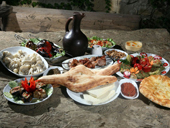
Georgian cuisine – something for every taste
By Nika Gamtsemlidze
Tuesday, May 7
A lot comes to mind when I think of Georgian cuisine. As every Georgian, I am very proud of it. The most unique part of Georgian cuisine is how diverse it really is. One can find anything for any taste, from sweet to sour, from hot to cold, Georgian cuisine can make anyone feel satisfied.
The influence of numerous empires that conquered Georgia throughout history, made the food in the country something that can turn every Supra (Georgian kind of feast) into an unforgettable experience.
Each historical province of Georgia has its distinct culinary tradition, with variations such as Abkhazian, Megrelian, Kakhetian, Imeretian, Svanetian, Tushian, Kartlian, Gurian, Meskhian, Rachian, and Adjarian Cuisines.
For example, Georgian cheese-bread, Khachapuri, has numerous interpretations. Some of them are so different that one might not even think that they are of the same kind. From the shape to taste, everything varies from province to province.
Today, I will try to show Georgian cuisine from my point of view. I have compiled some of the dishes that everyone who visits Georgia should try.
First of all, a dish that every tourist eats during their first visit to the country, Khinkali. Georgian version of a dumpling, full of juicy meat or sometimes cheese and potatoes, is one of the most popular dishes in Georgia. Everyone loves Khinkali, and there is one rule that Georgians (almost) always follow: eating Khinkali using bare hands. Yes, without any forks or knives, one has to use own hands. As they say, the best part of Khinkali is the juice, so you don’t want to waste it. Trust me, it’s very important.
Khachapuri is the undeniable staple of Supra, and no matter which part of Georgia you are going to visit, you will certainly have a chance of tasting it. Georgian cheese-bread is something that you definitely have to try. Georgian cheese is a thing of its own and no other cheese can make Khachapuri as juicy and creamy as it does.
Adjarian Khachapuri is one of the most popular variations of the cheese-bread. The boat-shaped bread from the coastal region is filled with lots of cheese and raw egg in the middle, which elevates the taste of the Georgian cheese-bread.
Another unique pastry comes from the mountainous Svaneti. Kubdari is a bread filled with beef, pork, or a combination of the two flavored with spices such as cumin, dill, coriander, blue fenugreek, red pepper, and others. What makes Kubdari unique is that the meat used in this dish should be cut, not minced.
Even though Georgian cuisine is rich with dairy products and meat, you can also find food suitable for vegetarians, the large quantity of plant-based dishes is motivated by the Georgian Orthodox Church. Fasting is a popular practice in Georgia, most of the church-goers spend most of the time fasting throughout the year. Which entails abstaining from any kind of meat or dairy products. Pkhali Georgian traditional dish made of chopped and minced vegetables, it is a cold vegetarian appetizer, popular Georgian tapas. Pkhali is often garnished with pomegranate seeds.
As mentioned above, Georgian cheese is unique. Georgians rely on cheese a lot, each region makes its own variety. Sulguni, a Megrelian cheese, is perhaps the most popular semi-soft Georgian cheese. Its high moisture content might remind you of Mozzarella, but still, it is totally different and unique. Guda is a pungent mountain cheese from Tusheti, traditionally made with sheep’s milk and aged in sheepskin. You will find Cheese at every Supra.
In our country, good cheese needs good Bread and that’s where Georgian Puri comes in. Georgian food starts with bread, and it is an essential component of the meal. Bread is baked in a traditional bread baking oven called Tone. Tones are made of clay and look like the top half of clay pots. A fire burns at the bottom which heats up the sides of the oven. The bread dough is sectioned off and slapped onto the side walls of the oven to bake, slowly developing its signature golden brown color. Shotis Puri is the most recognizable of the Georgian breads because of its oblong shape with pointed ends.
Another thing that you will find on Georgian Supra is a sauce called Tkemali, which is primarily made of Alucha or other varieties of plum. The sauce is used with pretty much everything, but it goes particularly well with the fried potatoes. Next, to Tkemali, you will always find Georgian-Abkhazian Adjika. Hot, spicy, but subtly flavored dip, often used to flavor food. In 2018, the technology of Adjika was inscribed on the list of Intangible Cultural Heritage of Georgia. It is made with hot red peppers, garlic, herbs, and spices.
Lobio is very popular Georgian dish as well. Made with beans, onions and Georgian herbs, this dish has as many tastes as the number of grandmothers in Georgia.
Georgian desserts are very unique to the country. Churchkhela, full of several walnuts or full hazelnuts put together, covered with Tatara (grape juice mixed with flour and sugar), is mostly made during Christmas. It needs several days to be made and can be stored for months. Some people call Churchkhela a “Georgian version of Snickers”. Churchkhela has a rich history, during wars, Georgian soldiers used to take the snack with them, for its high nutritious value.
Another popular Georgian dessert is Gozinaki, made of caramelized nuts, usually walnuts, fried in honey, and served exclusively on New Year's Eve and Christmas.
We can’t talk about Georgian cuisine and not say how great Georgian wine, or as Georgians call it, Ghvino, is. The whole country produces wine, every family knows how to make good wine. However, the most popular region that makes Gvino is Kakheti. Georgian wine is made in Qvevri, an egg-shaped clay jar. UNESCO has listed this technique as part of the Intangible Cultural Heritage of Humanity.
Of course, it is unimaginable to cover every aspect of Georgian cuisine in one article, but we hope that we were able to display the most important and interesting parts of it. Georgia’s rich culture has an enormous influence on the country’s food, and it can be felt in every bite of every dish.



